Are you ready to go on a witch hunt? …come on then!
Enchanting Hamamelis x intermedia Jelena
By 11th November 2012 the clusters of flowers from one of the witch hazels in my garden – Hamamelis x intermedia Jelena had just started to unfurl their magic. The flowers usually remain on the shrub for about 6 weeks and normally I have flowers from December right through until February on ‘Jelena’.
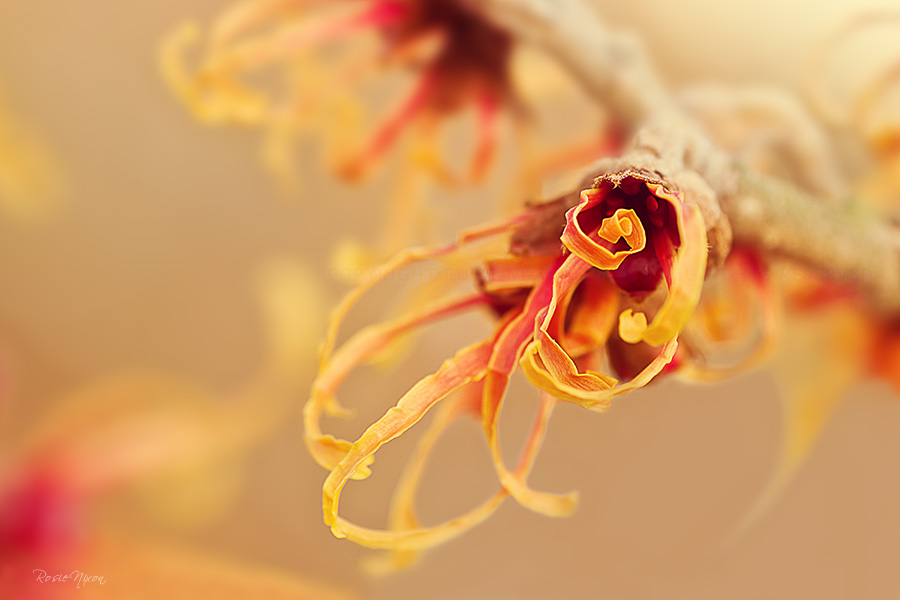
Each flower has 4 petals suffused with orange, red and copper tones while around the base of the petals are 4 burgundy wine sepals. Even once the 4 petals have gone the burgundy sepals still look attractive on the bare branches of the shrub.
Hamamelis x intermedia Jelena was my first purchase almost 11 years ago and I must admit that I was shocked at the price. Let’s just say that they are an investment as grafted or budded shrubs are always that bit more expensive.
After 11 years and now about 2 metres tall that investment is really showing it’s magic in the garden.
Winter Protection
The flowers are frost resistant. The plant produces a sugar called hamamelose which has the same effect as antifreeze and stops the flowers from freezing. Just like the snowdrops I wrote about a few years ago Snowdrops – Natures Antifreeze.
If you already have a witch hazel in your garden you’ll maybe never have noticed but the 4 spidery petals curl up more on cold nights to also protect themselves.
Even though Hamamelis x intermedia Jelena is hardy and in flower at this time of year it’s easy to forget that a newly purchased plant will still need a little bit of protection with horticutural fleece if it’s planted during the winter months. (Witch hazels are listed as being H5 – see the scottish hardiness ratings for further details).
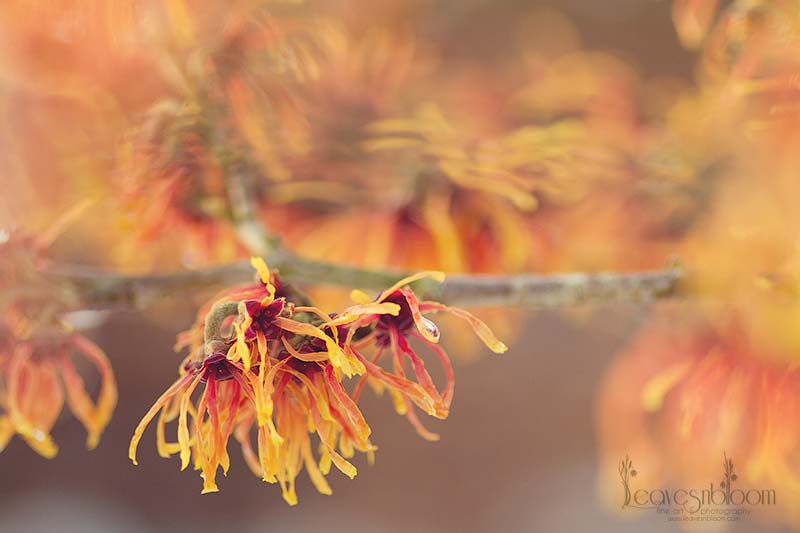
Caring for your Hamamelis x intermedia Jelena
#1 Here in Scotland they need to be planted in full sun while in sunnier locations further south they might prefer a more dappled shade position.
#2 All you need is a sheltered spot with good well drained soil – preferably on the acidic side.
#3 It’s best to plant it somewhere that it can been seen from indoors. As it matures you can cut a few branches to bring indoors and enjoy those lovely colours on your windowsill.
#4 Witch hazel ‘Jelena’ is quite vase like in appearance. It needs quite a little bit of room to ‘show off’ those branches as it will reach 3 metres tall.
#5 Don’t be surprised the plant doesn’t do much in it’s early years after being planted. They are slow to established in the garden and it’s a few years before you see much growth.
#6 As most witch hazels for sale are grafted or budded you might find that the odd shoot from the rootstock – Hamamelis virginiana will appear near the base of the plant. In all the years of growing Jelena I’ve only had to pull off a few suckers twice.
TIP: never cut off suckers but pull and tear them away from the rootstock. Otherwise you’ll just encourage more suckers to grow.
#7 Pruning is never drastic and if needed a little can be done in April. Prune the previous years growth back to two buds.
#9 As the shrub is deciduous it has a nice display of golden autumn foliage.
#10 Knock the snow off the branches using a bamboo cane. Even a few inches of snow can bend the branches right to the ground.
What’s in a Name………….who was Jelena?
Sometimes the greatest plant discoveries are not too far of the beaten track. This was certainly the case with Hamamelis x intermedia Jelena.
In amongst one of those thickets almost 50 years later Robert de Belder discovered ‘Jelena’. He named it after the Slovakian horticulturalist whom he had fallen in love with.
You can read more more about the horticulturalist Jelena de Belder here. They later discovered Hamamelis x intermedia ‘Diane’ and named it after their daughter. That same piece of land is now Kalmthout Arboretum. It’s renowned across Europe for its collection of Hamamelis.
The Witch Hunt!
You can see mature unpruned witch hazels at the Hamamelis Festival at Kalmthout Arboretum in Belgium. Hamamelisfeesten takes place every year between mid January and the end of February.
February is probably the best time to visit. There’s more of the under story of snowdrops and hellebores in flower. (there’s free entry to RHS members too!)




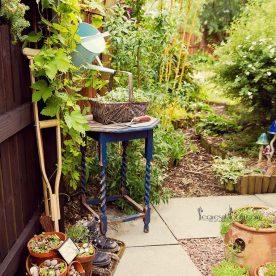
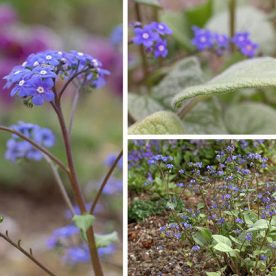
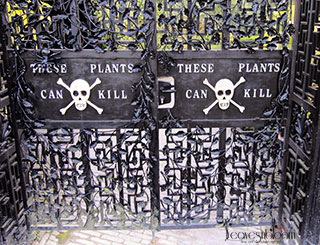
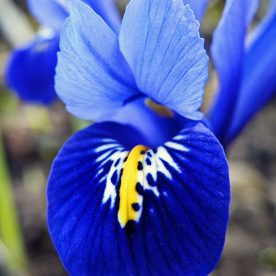
elaine rickett
You have captured their beauty wonderfully – what do they look like for the rest of the year?
Andrea Dawn
Thank you, Rosie! I went for a walk down my lane last week, with my camera, of course, and snapped some shots of these beauties but I had no idea what they were. So happy to have them identified and must say your shots are just gorgeous.
Anna
A most informative and beautifully illustrated post Rosie. If only Belgium were slightly nearer I would certainly make tracks for the Hamamelis Festival but I do hope to get to the slightly nearer Dunham Massey Winter Garden soon, to see the witches there 🙂
Gardening in a Sandbox
Hi Rosie: I bought a native witch hazel at the North American Native Plant Society sale a couple of years ago. The tag is still attached so I cannot tell you its genre. It is just a stick at the moment. Even the rabbit has no interest in it so far. I hope that some day I may have a bloom. Valerie
Rosie Nixon
@elaine rickett
quite green and boring during the summer but the leaves go golden in the autumn time
Rosie Nixon
@Andrea Dawn
Oh you're really fortunate to have these growing wild down that lane – such great photo opportunities!
Rosie Nixon
@Gardening in a Sandbox
So even your native ones must take awhile to establish – great news that the rabbits keep away but maybe it's because of the medicinal qualities of the bark
Mark and Gaz
Lovely macro shots Rosie! Witchhazels are great for adding colour to the garden during winter
Melanie J Watts
What a beautiful plant. I'm going to be in Vancouver in mid February, I hope the witch hazel is still in bloom so I can see it. Interesting info about hamamelose, this is the first I've heard of it. Great post Rosie.
Janet/Plantaliscious
What gorgeous shots of the witch hazel blooms, if I hadn't inherited one I would be trying to work out how to afford buying one! Mine is yellow, a soft yellow, others have suggested that it is 'Arnold's Promise' or Pallida, I haven't been able to decide which. It is beautiful, whatever it is called, I now just have to work out what to plant around it.
catharine Howard
Hello Rosie I have always liked the Jelena cv. We planted one at our last house and could hardly believe it when we visited and found it had been ripped out.
Rosie Nixon
@Mark and Gaz
Thank goodness we have them otherwise winter colour would be so limited
Rosie Nixon
@Melanie J Watts
Oh I hope they will be in flower
Rosie Nixon
@Janet/Plantaliscious
I'm hoping the my unidentified one is Arnold Promise. My pallida is out in flower more today but the unidentified one is still not quite there yet
Rosie Nixon
@catharine Howard
That's shocking! they mustn't have realised how beautiful it would have been during the winter nor how much they cost in a garden centre or nursery!
Alistair
Rosie, I have always admired this variety Jelena. It would make a nice change from the yellow Arnolds Promise in our garden, now where will it go. Lovely profile and pictures of this Witch Hazel, and yes they are very expensive.
Angie
After seeing your last set of pictures – I set out to buy Jelena, I could only source yellow in the 5 GCs I visited. I was not going to buy for buyings sake and therefore Jelena will remain on my wish list for now!
PlantPostings
These are by far the most beautiful images of Witch Hazel I have ever seen! Wow, very stunning! Words aren't enough, really. Thanks so much for sharing the images and all the great tips!
Jacky Quirke
Well done on your blog/website, beautiful shots.